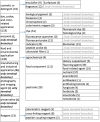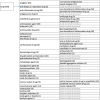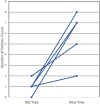An immunologically friendly classification of non-peptidic ligands
- PMID: 33772585
- PMCID: PMC8001080
- DOI: 10.1093/database/baab014
An immunologically friendly classification of non-peptidic ligands
Abstract
The Immune Epitope Database (IEDB) freely provides experimental data regarding immune epitopes to the scientific public. The main users of the IEDB are immunologists who can easily use our web interface to search for peptidic epitopes via their simple single-letter codes. For example, 'A' stands for 'alanine'. Similarly, users can easily navigate the IEDB's simplified NCBI taxonomy hierarchy to locate proteins from specific organisms. However, some epitopes are non-peptidic, such as carbohydrates, lipids, chemicals and drugs, and it is more challenging to consistently name them and search upon, making access to their data more problematic for immunologists. Therefore, we set out to improve access to non-peptidic epitope data in the IEDB through the simplification of the non-peptidic hierarchy used in our search interfaces. Here, we present these efforts and their outcomes. Database URL: http://www.iedb.org/.
© The Author(s) 2021. Published by Oxford University Press.
Figures










References
-
- Favre,H.A. and Powell,W.H. (2014) International Union of Pure and Applied Chemistry Nomenclature of Organic Chemistry: IUPAC Recommendations and Preferred Names 2013. Royal Society of Chemistry, Cambridge.
Publication types
MeSH terms
Substances
Grants and funding
LinkOut - more resources
Full Text Sources
Other Literature Sources

